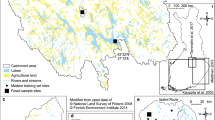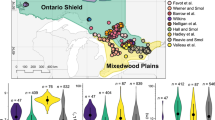Abstract
This paper aims to determine the ecological and chemical reference conditions (~1800–1850 AD) and degree of floristic change at nine enriched lakes, covering a range of types across Europe, using fossil diatom assemblages in dated sediment cores and application of total phosphorus (TP) transfer functions. Additionally the study assesses the potential of analogue matching as a technique for identifying reference sites and for estimating reference TP concentrations for the study lakes using a training set of 347 European lakes and 719 diatom taxa. Oligotrophic, acidophilous to circumneutral taxa were predominant in the reference samples of several of the deep lakes, and benthic Fragilaria spp. dominated the reference samples of two high alkalinity shallow lakes. The degree of floristic change from the reference sample, assessed using the squared chord distance (SCD) dissimilarity coefficient, revealed that two sites had experienced slight change (Lago Maggiore, Felbrigg Lake), five experienced moderate change (Mjoesa, Loch Davan, Loch Leven, White Lough, Esthwaite Water), and two showed evidence of major change (Groby Pool, Piburger See). For three lakes, there were no analogues in the diatom dataset owing to the uniqueness and diversity of the diatom reference assemblages. For the remaining six sites the number of analogues ranged from 2 to 44. For two deep lakes most of the analogues seemed appropriate as they were of the same type and had low TP concentrations. However, for two other deep lakes and two shallow lakes some of the analogues differed markedly in their depth and alkalinity from the lake in question or had TP concentrations seemingly too high to represent reference conditions suggesting that the analogues may not be suitable as reference sites. For the deep lakes, similar reference TP values were calculated using the EDDI Combined TP transfer function and the analogue matching technique with concentrations typically <20 μg L−1. However, for the shallow lakes, the analogue matching method produced inferred values considerably higher than those of the transfer function. The wide ecological tolerances of many of the diatom taxa found in the reference samples most likely explain the selection of inappropriate analogue sites. In summary, the study demonstrates that palaeoecological techniques can play a valuable role in determining reference conditions and indicates that the analogue matching technique has the potential to be a useful tool for identifying appropriate reference sites for lakes impacted by eutrophication.






Similar content being viewed by others
References
Anderson NJ (1997) Reconstructing historical phosphorus concentrations in rural lakes using diatom models. In: Tunney H, Carton OT, Brookes PC, Johnstone AE (eds) Phosphorus losses from soil to water. Cab International, Wallingford, pp 95–118
Anonymous (2003) Common implementation strategy for the water framework directive (2000/60/EC). Guidance on establishing reference conditions and ecological status class boundaries for inland surface waters. Available at: http://forum.europa.eu.int/Public/irc/env/wfd/library
Battarbee RW (1978) Observations on the recent history of Lough Neagh and its drainage basin. Philos Trans R Soc Lond 281:303–345
Battarbee RW, Jones VJ, Flower RJ, Cameron NG, Bennion H, Carvalho L, Juggins S (2001a) Diatoms. In: Smol JP, Birks HJB, Last WM (eds) Tracking environmental change using lake sediments. vol 3: terrestrial, algal, and siliceous indicators. Kluwer, Dordrecht, pp 155–202
Battarbee RW, Juggins S, Gasse F, Anderson NJ, Bennion H, Cameron NG, Ryves DB, Pailles C, Chalie F, Telford R (2001b) European Diatom Database (EDDI). An information system for palaeoenvironmental reconstruction. ECRC Research Report No 81, University College London, 94 pp
Battarbee RW, Monteith DT, Juggins S, Evans CD, Jenkins A, Simpson GL (2005) Reconstructing pre-acidification pH for an acidified Scottish loch: a comparison of palaeolimnological and modelling approaches. Environ Pollut 137:135–149
Battarbee RW, Morley D, Bennion H, Simpson GL, Hughes M, Bauere VA (2010) A palaeolimnological meta-database for assessing the ecological status of lakes. J Paleolimnol (this issue). doi:10.1007/s10933-010-9417-5
Bennion H (1995) Surface sediment diatom assemblages in shallow, artificial, enriched ponds, and implications for reconstructing trophic status. Diatom Res 10:1–19
Bennion H, Battarbee R (2007) The European Union Water Framework Directive: opportunities for palaeolimnology. J Paleolimnol 38:285–295
Bennion H, Simpson GL (2010) The use of diatom records to establish reference conditions for UK lakes subject to eutrophication. J Paleolimnol (this issue). doi:10.1007/s10933-010-9422-8
Bennion H, Monteith D, Appleby P (2000) Temporal and geographical variation in lake trophic status in the English Lake District: evidence from (sub)fossil diatoms and aquatic macrophytes. Freshwat Biol 45:394–412
Bennion H, Appleby PG, Phillips GL (2001a) Reconstructing nutrient histories in the Norfolk Broads, UK: implications for the role of diatom-total phosphorus transfer functions in shallow lake management. J Paleolimnol 26:181–204
Bennion H, Fluin J, Appleby P, Ferrier B (2001b) Palaeolimnological investigation of Scottish freshwater lochs. Final report to SNIFFER No. SR(00)02 by ENSIS Ltd, University College London, 424 pp
Bennion H, Simpson G, Hughes M, Phillips G, Fozzard I (2003) The role of palaeolimnology in identifying reference conditions and assessing ecological status of lakes. In: Ruoppa M, Heinonen P, Pilke A, Rekolainen S, Toivo H, Vuoristo H (eds) How to assess and monitor ecological quality in freshwaters. Tema Nord 547. Nordic Council of Ministers, Copenhagen, pp 57–63
Bennion H, Fluin J, Simpson GL (2004) Assessing eutrophication and reference conditions for Scottish freshwater lochs using subfossil diatoms. J Appl Ecol 41:124–138
Bradbury JP (1975) Diatom stratigraphy and human settlement in Minnesota. Geol Soc Am Special Paper 171:1–74
European Union (2000) Directive 2000/60/EC of the European Parliament and of the Council of 23 October 20000 establishing a framework for Community action in the field of water policy. Off J Eur Communities L327:1–72
Faith DP, Minchin PR, Belbin L (1987) Compositional dissimilarity as a robust measure of ecological distance. Plant Ecol 69:57–68
Flower RJ, Juggins SJ, Battarbee RW (1997) Matching diatom assemblages in lake sediment cores and modern surface sediment samples: the implications for conservation and restoration with special reference to acidified systems. Hydrobiologia 344:27–40
Gavin DG, Oswald WW, Wahl ER, Williams JW (2003) A statistical approach to evaluating distance metrics and analog assignments for pollen records. Quatern Res 60:356–367
Hall RI, Smol JP (1999) Diatoms as indicators of lake eutrophication. In: Stoermer EF, Smol JP (eds) The diatoms: applications for the environmental and earth sciences. Cambridge University Press, Cambridge, pp 128–168
Juggins S (2001) The European diatom database user guide version 1.0. University of Newcastle, Newcastle upon Tyne 72 pp
Marchetto A, Lami A, Musazzi S, Masaferro J, Langone L, Guilizzoni P (2004) Lake Maggiore (N. Italy) trophic history: fossil diatoms, plant pigments, chironomids and comparison with long-term limnological data. Quatern Int 113:97–110
Overpeck JT, Webb T, Prentice IC (1985) Quantitative interpretation of fossil pollen spectra—dissimilarity coefficients and the method of modern analogs. Quatern Res 23:87–108
Pollard P, Huxham M (1998) The European Water Framework Directive: a new era in the management of aquatic ecosystem health? Aquat Conserv Mar: Freshwat Ecosyst 8:773–792
Prentice IC (1980) Multidimensional scaling as a research tool in Quaternary palynology: a review of theory and methods. Rev Palaeobot Palynol 31:71–104
R Development Core Team (2008) R: a language and environment for statistical computing. R Foundation for Statistical Computing, Vienna, Austria. ISBN 3-900051-07-0, URL http://www.R-project.org
Round FE, Crawford RM, Mann DG (1990) The diatoms: biology and morphology of the genera. Cambridge University Press, Cambridge, p 747
Saros JE, Michel TJ, Interlandi SJ, Wolfe AP (2005) Resource requirements of Asterionella formosa and Fragilaria crotonensis in oligotrophic alpine lakes: implications for recent phytoplankton community reorganizations. Can J Fish Aquat Sci 62:1681–1689
Sawada M, Via AE, Vettoretti G, Peltier WR, Gajewski K (2004) Comparison of North-American pollen-based temperature and global lake-status with CCCma AGCM2 output at 6 ka. Quatern Sci Rev 23:225–244
Sayer CD (2001) Problems with the application of diatom-total phosphorus transfer functions: examples from a shallow English lake. Freshwat Biol 46:743–757
Sayer CD, Burgess A, Kari K, Davidson TA, Peglar S, Yang H, Rose N (2010) Long-term dynamics of submerged macrophytes and algae in a small and shallow, eutrophic lake: implications for the stability of macrophyte-dominance. Freshwat Biol 55:565–583
Sayer CD, Roberts N (2001) Establishing realistic restoration targets for nutrient-enriched shallow lakes: linking diatom ecology and palaeoecology at the Attenborough Ponds, UK. Hydrobiologia 448:117–142
Schelske CL, Donar CM, Stoermer EF (1999) A test of paleolimnologic proxies for the planktonic/benthic ratio of microfossil diatoms in Lake Apopka. In: Mayama S, Idei M, Koizumi I (eds) Proceedings of the 14th international diatom symposium. Koeltz Scientific Books, Koenigstein, pp 367–382
Simpson GL (2007) Analogue methods in palaeoecology: using the analogue package. J Stat Softw 22:1–29
Simpson GL, Oksanen J (2009) analogue: analogue matching and Modern Analogue Technique transfer function models (R package version 0.6-22 ). http://cran.r-project.org/package=analogue
Simpson GL, Shilland EM, Winterbottom JM, Keay J (2005) Defining reference conditions for acidified waters using a modern analogue approach. Environ Pollut 137:119–133
Tilman D (1982) Resource competition and community structure. Monographs in Population Biology. Princeton University Press, Princeton, p 296
Vadeboncoeur Y, Jeppesen E, Vander Zanden MJ, Schierup H, Christoffersen K, Lodge DM (2003) From Greenland to green lakes: cultural eutrophication and the loss of benthic pathways in lakes. Limnol Oceanog 48:1118–1408
Wahl ER (2004) A general framework for determining cutoff values to select pollen analogs with dissimilarity metrics in the modern analog technique. Rev Palaeobot Palynol 128:263–280
Acknowledgments
This paper was written with support from the European Union (FP6 Integrated Project ‘Euro-limpacs: European project to evaluate impacts of global change on freshwater ecosystems’ GOCE-CT-2003-505540) and the Scotland and Northern Ireland Forum for Environmental Research (SNIFFER, project number WFD08). Thank you to two anonymous reviewers for their valuable comments.
Author information
Authors and Affiliations
Corresponding author
Rights and permissions
About this article
Cite this article
Bennion, H., Simpson, G.L., John Anderson, N. et al. Defining ecological and chemical reference conditions and restoration targets for nine European lakes. J Paleolimnol 45, 415–431 (2011). https://doi.org/10.1007/s10933-010-9418-4
Received:
Accepted:
Published:
Issue Date:
DOI: https://doi.org/10.1007/s10933-010-9418-4




